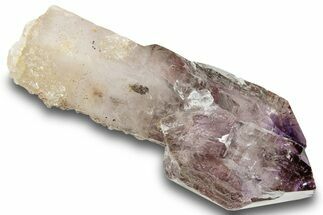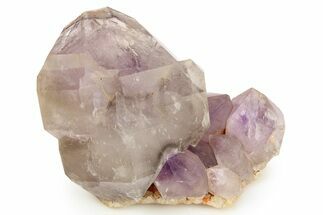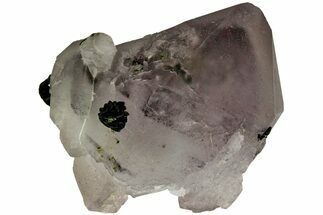This Specimen has been sold.
1.12" Shangaan Amethyst Scepter - Chibuku Mine, Zimbabwe
Shangaan amethyst is the trade name for beautiful, smoky amethyst mined by the Shangaan tribal groups of southeastern Africa. It comes from the Chibuku mine located in Zimbabwe near the border with Mozambique. Shangaan amethyst is a relatively new find, just appearing on the commercial market in the last few years.
These distinctive crystals are often very dark in color and contain small, red, flake-like hematite inclusions peppered throughout. These crystals frequently form individual scepters and occasionally include enhydros--small bubbles of water--trapped within. You can look for an enhydro in your crystal by backlighting the specimen and rotating the crystal, looking for the movement of air bubbles in water within.
These distinctive crystals are often very dark in color and contain small, red, flake-like hematite inclusions peppered throughout. These crystals frequently form individual scepters and occasionally include enhydros--small bubbles of water--trapped within. You can look for an enhydro in your crystal by backlighting the specimen and rotating the crystal, looking for the movement of air bubbles in water within.
About Quartz
Quartz is the name given to silicon dioxide (SiO2) and is the second most abundant mineral in the Earth's crust. Quartz crystals generally grow in silica-rich environments--usually igneous rocks or hydrothermal environments like geothermal waters--at temperatures between 100°C and 450°C, and usually under very high pressure. In either case, crystals will precipitate as temperatures cool, just as ice gradually forms when water freezes. Quartz veins are formed when open fissures are filled with hot water during the closing stages of mountain formation: these veins can be hundreds of millions of years old.
Quartz is the name given to silicon dioxide (SiO2) and is the second most abundant mineral in the Earth's crust. Quartz crystals generally grow in silica-rich environments--usually igneous rocks or hydrothermal environments like geothermal waters--at temperatures between 100°C and 450°C, and usually under very high pressure. In either case, crystals will precipitate as temperatures cool, just as ice gradually forms when water freezes. Quartz veins are formed when open fissures are filled with hot water during the closing stages of mountain formation: these veins can be hundreds of millions of years old.
Amethyst is a purple variety of quartz (SiO2) that owes its violet color to natural gamma irradiation, iron impurities, and the presence of trace elements, which result in complex crystal lattice substitutions. It is considered a semi-precious gemstone, and just two centuries ago was considered to have a value on par with diamonds, sapphires, and rubies. The largest and best known amethyst deposits occur in southern Brazil and Uruguay, where they are found in hydrothermally-formed geodes, but many localities around the world produce an amazing variety of amethyst crystals and formations. They are almost always formed in medium- to high-temperature geological settings.
Smoky quartz is a grey-brown to black variety of quartz. This common name is derived from the appearance of smoke within the quartz crystal. Depending on the location and the chemicals present during formation, smoky quartz can appear opaque black, but it is typically translucent to some extent. It is believed that the quartz gains this color from a combination of natural irradiation and aluminum impurities.
SPECIES
Quartz var. Amethyst/Smoky & Hematite
LOCATION
Gezani Communal Land, Chibuku Mine, Zimbabwe
SIZE
1.12" long
CATEGORY
SUB CATEGORY
ITEM
#149298
 Reviews
Reviews













